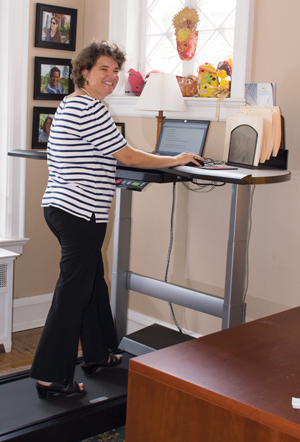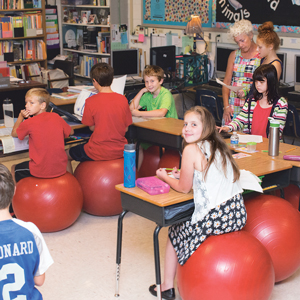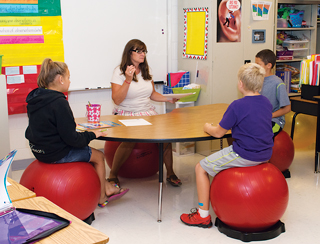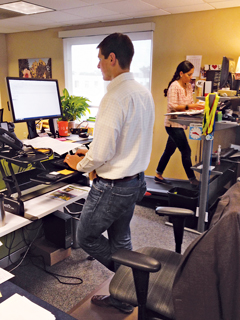
It seems everyone in our family is sitting for a good portion of the day. My husband and I have office jobs. Our children are sitting in school for what appears to be longer durations as they get older. When a desk jockey like me reads Sitting is the new smoking! I want to learn about ways to change my seating arrangement and how to get my kids off their respective bottoms, too.
You may have seen treadmill workstations and standing workstations in the news. What’s all the buzz about? The health concerns related to living a sedentary lifestyle are sobering, including results from a landmark study that revealed even regular exercise does not counteract the effects of prolonged sitting.
Workstations are typically associated with the corporate environment. However, standing workstations, treadmill desks, or walkstations can also be used in home offices or in a common location that everyone in the family can appreciate. Wendy Martin, consultant and speech writer, lives and works at her home in the Museum District. After taking a test drive on a new walkstation several years ago, she was hooked. The price tag was another matter.
Martin, who ultimately scored a used walkstation online in good condition at a fraction of the original cost, says the investment was a worthwhile one. “It isn’t so much that I am getting two to three miles of walking in a day, but that I am eliminating hours of sitting,” Martin said, adding that for her, the walkstation works best for editing, Internet research, responding to email, participating in webinars, and interviewing clients. When talking on the phone with clients, she says, “Most people don’t even know that I am on the treadmill instead of being chained to a desk, since the treadmill is so quiet.”
If you’re thinking the experience is like the standard workout, think again. Although you may have visions of running and typing at the gym, this is not the model for an effective and safe walkstation. First, some walkstations are specifically designed for walking longer periods. Second, think of it as a way to increase blood flow and get moving – not a sweat-producing operation. Although individuals will want to adjust pace according to their own needs, recommendations are no more than two miles an hour while multi-tasking. Treadmill desks are often called walkstations because they are only meant for walking, rather than a true workout. In fact, one of the disclaimers on the walkstation I looked at clearly reads: This is not an exercise machine!
Fine by me, as the fast pace of exercise treadmills and I do not have such a great track record. But I was wondering how comfortable I would feel using a walkstation. After adjusting for my height, I began walking very slowly (.3 miles per hour) and worked my way up to one-and-a-half miles per hour, which was the perfect pace for me to efficiently check email and do a little typing.

According to Paul E. Caldwell, MD, of Tuckahoe Orthopaedics, the benefits of getting moving are extensive. He cites improved vascular health and increased fitness. “It is a great idea to engage other muscle groups and work on postural control – strengthening your core. Ideally, you want to keep your body mobile. Incorporating a variety of positions with some sitting, some standing, all with good posture is optimal.” Some studies show other benefits of introducing the active-working and walkstation model to the work environment include increased employee morale and roductivity, and decreased employee absences and healthcare costs.
But, as Dr. Caldwell cautions, “There can be some safety issues associated with walkstations. Your concentration is somewhere else, so avoid distractibility as much as possible.” Proponents of walkstations suggest facing treadmills out, so that the walker’s back is to the wall. Co-workers should approach the walker from the front or at a forty-five degree angle – never from behind the walker. For the active worker, being able to scan the environment is important to prevent getting startled.
At home, Martin notes one downside. “You’ve got to have the space for a walkstation.” For compact areas, standing workstations may be a good alternative, which typically take up no more space than a sitting workstation. Adjustable sit-to-stand workstations offer the most versatility.
Pete Woody, public relations and communications manager for Sports Backers, says the Richmond company, which is known for promoting active lifestyles, has embraced using treadmill workstations and standing workstations. “We currently have two staff members using treadmill desks and twelve using sit-to-stand desks, which can be raised and used as standing desks or lowered to sit, so it’s really great to have the option to stand throughout the day.” Woody continued, “On a personal level, standing helps keep me stay more alert and helps with my focus on different tasks; it also helps avoid some lower back pain that can come from sitting and slouching for a
long time.”
That sitting and the slouching that comes with it, says Dr. Caldwell, might not have the average employee’s full consideration. “When you take a job, you don’t consider the health implications of sitting all day, although you would probably think twice if you were working in a situation with an environmental hazard, such as asbestos,” said Dr. Caldwell. “Sitting for extended periods of time during the day is very different to how we used to work – and the health concerns as a result are what you can call an epidemic.”

And it is an epidemic that affects our children, too. That’s why Ann Wallace and Luann Morrow, teachers at Pearson’s Corner Elementary School in Hanover County, developed an initiative to get students on the ball – literally. At their school, fourth and fifth graders give new meaning to the term active learning, sitting on balance balls in class, rather than on standard chairs. The initiative, which started with one classroom, is now in action in three different classrooms. Community partners stepped up to provide balance balls through a mini-grant from the Taylor Educational Foundation.
Initially, students were trained in using the balance balls appropriately. Instruction included how to sit properly on the balance balls, bouncing lightly, rather than vigorously, shifting from side to side, and demonstrating feet flat on the floor. In addition to discussion of these rules, parents who were also physical therapists spoke with students about the importance of strengthening core muscles. This encouragement and sense of ownership started early on, Wallace explained. They told students, “This is not a ball; it is your chair. You wouldn’t throw a chair, so we don’t throw balls.” In addition, Wallace said she sits on a balance ball at her classroom computer to model appropriate sitting behavior.
Morrow believes using the balance balls fosters on-task behaviors more than the standard chairs. “For students with excessive energy who are often out of their seats because they just cannot sit any longer, it provides another, more appropriate, outlet for movement,” said Morrow. “And for those students who often get lost in thought and are slouching or leaning back and tuning out, it maintains focus.” The teachers concluded that even small movements like these help students stay more alert and keep students’ brains and bodies from shutting down.
The teachers report that their students have responded positively, with only one child requesting the return of the standard chair in three years. Morrow continued, “What surprised me most was how quickly the students adapted to the balls and the rules regarding their use.”
It took some time for these Hanover County educators to get used to teaching students in this manner. “Sometimes it looks like a shifting sea of movement from the teacher’s perspective,” said Wallace.
Dr. Caldwell suggests that having a more active classroom may also decrease the need for kids to fidget. But he also says the balance ball is not the only solution. “It is still possible to slouch sitting on a balance ball, so it is critical that individuals sit up straight and truly work their core.” He says even though sitting on balance balls can strengthen the core muscles, equipment should be used properly. “It is important to use different ball sizes to adjust for individual size differences, as well as using the stand that the ball sits on for safety.”

Dr. Caldwell notes another use of balls in the classroom, but this one is more abstract. “Otherwise healthy high school students come into my office with neck pain and poor posture. It is easy to see exactly what the problem is right away. These students have been sitting hunched over their desks for years, which takes a toll. I tell them to sit up straight, engage their core [muscles] and imagine that they are holding a ball between their scapulae [shoulder blades].” Dr. Caldwell continues, “Starting gradually so that you are building up stamina is key to maintaining a program. If you are not used to using good posture and typically sit all hunched over, using good posture can be exhausting.”
While good posture is important, keeping kids in motion is important too. A program at Bailey Bridge Middle School in Chesterfield County lets students obtain a library pass to do their silent reading in the library – not at a desk, but on a bicycle. Librarian Kim Kuhn explains that she got the idea from a colleague and that in her search for a stationary bicycle, she chose one of the quietest models to fit in with the library environment. “Having wheels in motion makes reading fun, and serves a dual purpose.” Kuhn says, “We want the library to be the hub of the building and this is another way to get students into the library.” Kuhn says students are expected to bike for fifteen minutes and they log virtual miles in the Read Across America program. As they figuratively pedal across America, the kids learn geography, cartography, and of course, math.
So what can parents do at home (besides encouraging kids to sit up straight) to further the cause of active learning? Dynamic homework activities are creative ways to incorporate movement while recalling facts or studying for tests, like jumping on a trampoline, swinging on a swing, or playing Twister all while trying to spell words or recalling the facts to prepare for a quiz. Some children even appreciate the rhythm of skipping rope or bouncing a ball when working on memory recall of math facts.

Something Dr. Caldwell said about the professional environment also applies to kids and their studies. “While no one can easily change jobs, you can change the way you do your job.” So for kids’ written homework, consider changing the muscles they have been using during the day by writing on a slanted surface such as an easel, or a vertical surface such as a sliding glass door. Younger children may also appreciate doing short amounts of written work lying on their backs on the floor and using the under surface of a table for writing on paper (think Michelangelo!). Alternatively, encourage kids to take a cue from the other examples here for studying at home – set up your child’s workstation with a balance ball as their chair or offer a spin on a stationary bike while reading.
Dr. Caldwell notes that in most cases, people have been sitting at desks for years. “It took a long time to get to where you are, so it will take a long time to get to where you need to be. Work up to improving posture and fitness gradually.”



